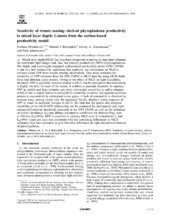| dc.contributor.author | Milutinović, Svetlana | eng |
| dc.contributor.author | Behrenfeld, Michael J. | eng |
| dc.contributor.author | Johannessen, Johnny A. | eng |
| dc.contributor.author | Johannessen, Truls | eng |
| dc.date.accessioned | 2009-10-20T11:21:07Z | |
| dc.date.available | 2009-10-20T11:21:07Z | |
| dc.date.issued | 2009-10-01 | eng |
| dc.Published | Global Biogeochemical Cycles 23(GB4005): 16 pp. | en |
| dc.identifier.issn | 0886–6236 | en_US |
| dc.identifier.uri | https://hdl.handle.net/1956/3525 | |
| dc.description.abstract | Mixed layer depth (MLD) has long been recognized as having an important influence on underwater light budget and, thus, net primary productivity (NPP) of phytoplankton. The depth- and wavelength-integrated carbon-based productivity model (DWI CbPM) is one of a few productivity algorithms that explicitly use information on MLD to estimate ocean NPP from remote sensing observations. This study evaluates the sensitivity of NPP estimates from the DWI CbPM to MLD input by using MLD fields from four different ocean models. Owing to the effect of MLD on light availability, the model NPP is generally inversely related to MLD, but the strength of this relationship is highly variable. In most of the ocean, it exhibits a seasonal character. In summer, NPP at middle and high latitudes can show substantial sensitivity to subtle changes in MLD, but is largely robust to strong MLD variability in winter. An opposite seasonal pattern is encountered in subtropical ocean gyres. A lack of seasonality is observed in tropical areas, among which only the equatorial Pacific displays strong response of NPP to small or moderate changes in MLD. We find that the spatial and temporal variability of the MLD-NPP relationship can be explained by nonlinearity and light saturation/limitation thresholds indicated in the DWI CbPM, as well as the influence of surface irradiance (I0) and diffuse attenuation coefficient for downwelling light at 490 nm (Kd(490)). NPP is sensitive to varying MLD only if coincidental I0 and Kd(490) values are such that combined with the coexisting differences in MLD estimates, they have potential to give effective differences in light saturation/limitation of photosynthesis. | en_US |
| dc.language.iso | eng | eng |
| dc.publisher | American Geophysical Union | en_US |
| dc.subject | Oceanography | eng |
| dc.title | Sensitivity of remote sensing – derived phytoplankton productivity to mixed layer depth: Lessons from the carbon-based productivity model | en_US |
| dc.type | Peer reviewed | |
| dc.type | Journal article | |
| dc.identifier.doi | https://doi.org/10.1029/2008gb003431 | |
| dc.subject.nsi | VDP::Matematikk og Naturvitenskap: 400 | nob |
